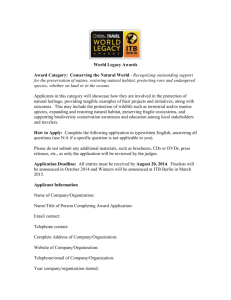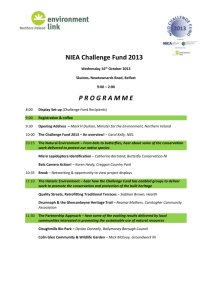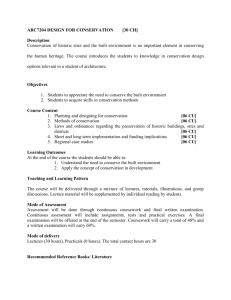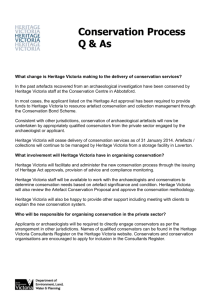SUSTAINABLE MATERIALS FOR THE CONSERVATION OF
advertisement
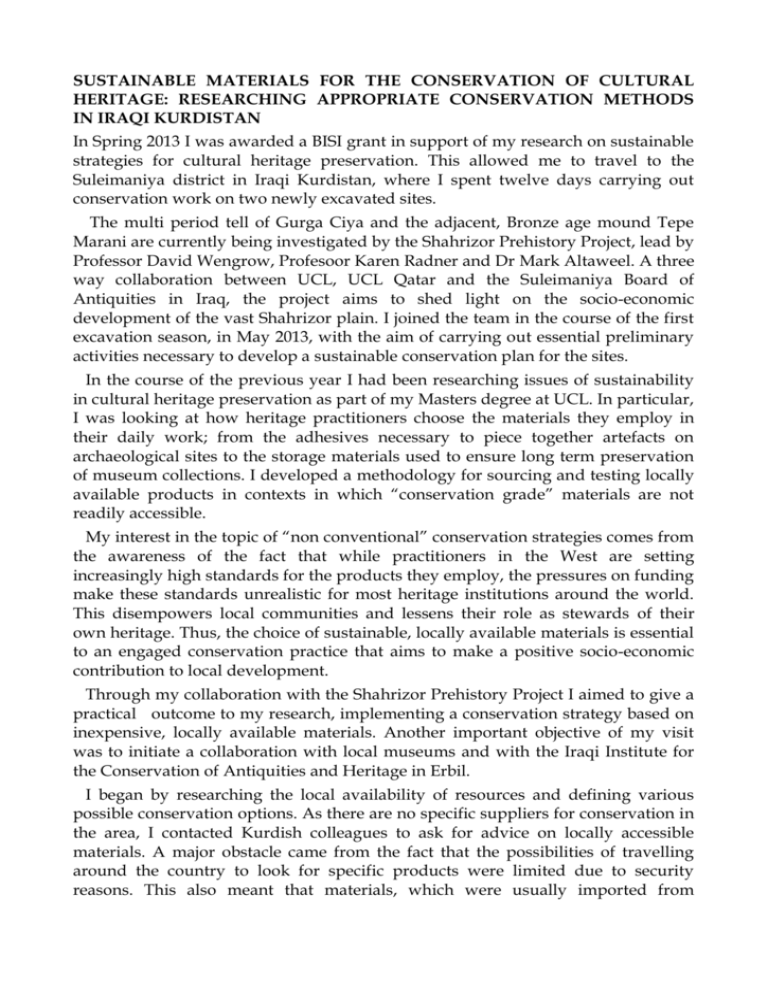
SUSTAINABLE MATERIALS FOR THE CONSERVATION OF CULTURAL HERITAGE: RESEARCHING APPROPRIATE CONSERVATION METHODS IN IRAQI KURDISTAN In Spring 2013 I was awarded a BISI grant in support of my research on sustainable strategies for cultural heritage preservation. This allowed me to travel to the Suleimaniya district in Iraqi Kurdistan, where I spent twelve days carrying out conservation work on two newly excavated sites. The multi period tell of Gurga Ciya and the adjacent, Bronze age mound Tepe Marani are currently being investigated by the Shahrizor Prehistory Project, lead by Professor David Wengrow, Profesoor Karen Radner and Dr Mark Altaweel. A three way collaboration between UCL, UCL Qatar and the Suleimaniya Board of Antiquities in Iraq, the project aims to shed light on the socio-economic development of the vast Shahrizor plain. I joined the team in the course of the first excavation season, in May 2013, with the aim of carrying out essential preliminary activities necessary to develop a sustainable conservation plan for the sites. In the course of the previous year I had been researching issues of sustainability in cultural heritage preservation as part of my Masters degree at UCL. In particular, I was looking at how heritage practitioners choose the materials they employ in their daily work; from the adhesives necessary to piece together artefacts on archaeological sites to the storage materials used to ensure long term preservation of museum collections. I developed a methodology for sourcing and testing locally available products in contexts in which “conservation grade” materials are not readily accessible. My interest in the topic of “non conventional” conservation strategies comes from the awareness of the fact that while practitioners in the West are setting increasingly high standards for the products they employ, the pressures on funding make these standards unrealistic for most heritage institutions around the world. This disempowers local communities and lessens their role as stewards of their own heritage. Thus, the choice of sustainable, locally available materials is essential to an engaged conservation practice that aims to make a positive socio-economic contribution to local development. Through my collaboration with the Shahrizor Prehistory Project I aimed to give a practical outcome to my research, implementing a conservation strategy based on inexpensive, locally available materials. Another important objective of my visit was to initiate a collaboration with local museums and with the Iraqi Institute for the Conservation of Antiquities and Heritage in Erbil. I began by researching the local availability of resources and defining various possible conservation options. As there are no specific suppliers for conservation in the area, I contacted Kurdish colleagues to ask for advice on locally accessible materials. A major obstacle came from the fact that the possibilities of travelling around the country to look for specific products were limited due to security reasons. This also meant that materials, which were usually imported from Baghdad were not available in the region at that time. I reviewed the available options, testing the suitability of products and comparing costs. I collected samples of local materials that were recommended to me, and later took them to the UK for more extensive testing. All materials passed accelerated ageing and other tests with good results. With guidance from Renata Peters (UCL Lecturer in Conservation of Archaeological Artefacts) and the invaluable assistance of local colleagues I set up a basic lab and put in place measures for the care and appropriate storage of the artefacts. I agreed a protocol with the rest of the team for packaging in view of the end-of-season transport of finds to Suleimaniya, and for storage in the museum over the course of the following year. The results of my research will help to define the long term conservation plan for the site. They also formed part of my MSc dissertation, of which the Shahrizor Prehistory Project was a main case study. I would like to take the opportunity to thank The British Institute for the Study of Iraq for supporting my initiative. Flavia Ravaioli




